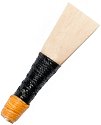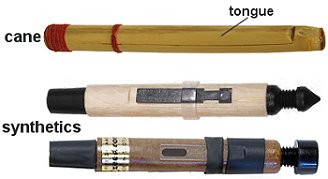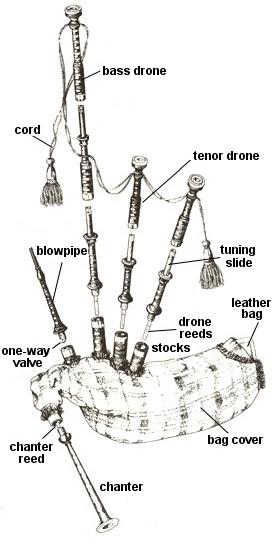| The Great Highland Bagpipe - An Overview Bagpipes are a class of musical instrument called aerophones, using enclosed reeds fed from a constant reservoir of air in the form of a bag.
Though the Scottish Great Highland Bagpipe have the greatest international visibility, bagpipes have been played for centuries throughout large parts of Europe, the Caucasus,
Turkey, around the Persian Gulf, and in Northern Africa. Bagpipes have been played in Scotland for more than six centuries.
The term bagpipe is equally correct in the singular or plural, although, pipers most commonly speak of them simply as "the pipes".
The instrument consists of a leather bag (or synthetic material) covered in decorative fabric, which
the piper inflates via a blowstick. The bag serves as a reservoir/manifold and the air
pressure is directed into four sounding locations: the chanter where the actual melody is emitted
and three drones which are constantly playing a harmonious background. Two of the drones are the
tenors and the longest is the bass. All three are tuned to the chanter by
shortening or lengthening them along tuning slides. It is critical that the drones and chanter
are tuned to each other, or the resulting sound is at best unpleasant. This reason alone explains why too
many people believe the pipes nothing less than shrill and harsh noisemakers only because they've never heard
properly tuned pipes played proficiently.
To play, the piper places the bag under his left arm and alternately inflates and squeezes air at a
constant pressure through the chanter and drones. The art of piping is to produce an even tone and avoid
any rise and fall in sound, or pauses between notes. It's a common misconception that the piper pumps the bag.
Simultaneously, he must play memorized tunes, maintain rhythm, and walk or march about as needed. Few skilled
pipers could be called klutzes.
For our convenience, pipe music is written in standard musical notation without sharps or flats. It has been claimed
that this unusual scale resembles the human voice, hence the old saying, "Let the pipes speak.", and
the fascination so many people have with them. Children are particularly susceptible - ever read the
story of The Pied Piper of Hamlin?
When listening to the bagpipes, one hears blips, chirps, and ripples throughout the music.
These are intentional and known as grace notes. They consist of rapid short notes or elaborate
combinations of short notes inserted between the notes of the melody and give the music its distinctiveness.
And the various grace notes even have tongue-bending Gaelic names such as leumluath and taorluath.
 Grace notes separate main notes, add body, and serve as accents, since the continuous airflow prevents breaks or rests during performances. Without grace notes, pipe music would sound terribly dull, even lifeless - akin to beer without carbonation. |
| To the right is a typical chanter reed. These are the very heart of the instrument and are made by carefully planing and shaping pieces of cane (Arundo donax) until 1.5" to 1.75" in length and ~0.5" wide. Then they are wrapped securely around a small metal tube known as a staple. Chanter reeds are a double-bladed reed similar to those used in oboes and bassoons. They are created by a variety of reedmakers each with his own idea of how to produce the best product. |  |

Drone reeds (below) are snugly fitted into the bottom of the drones which are subsequently friction fitted to interfaces called stocks which are
tied tightly to the bag. Drone reeds are of two types: natural and synthetic. The one on the top is a
traditional cane reed. It's a hollow cane tube with a tongue that vibrates when air passes through it.
They are renown for their capricious temperment. Even slight changes in weather can cause cane drone reeds to go out of tune or shut down.
The two reeds at bottom are the collective idea of contemporary pipers who wanted something durable, reliable, and dependable. These reeds are
made from various plastics and carbon fibers. They should last years with little maintenance. Weather conditions usually have little effect on synthetics.
There are several manufacturers of synthetic drone reeds, each claiming to have the latest features or truest sound.
The biggest difference between the two types is cost. Cane reeds are several dollars each, while a
set of synthetic drone reeds can cost well over a hundred bucks.

Note to Piper-Webmasters: unauthorized use of any intellectual property on this website is THEFT. Use of any material jeopardizes this website's ranking and steps shall be taken to remedy the situation.

